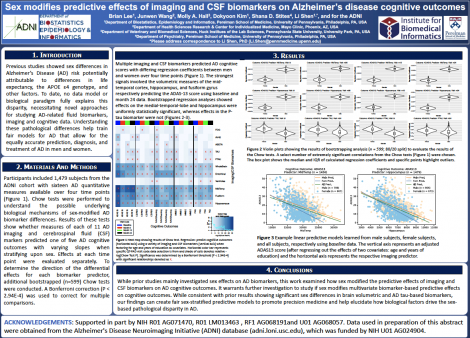Brian Lee
Sex Modifies Predictive Effects of Imaging and CSF Biomarkers on Alzheimer’s Disease Cognitive Outcomes

Presenter

Brian Lee is an undergraduate research assistant in the Shen Lab. His research focuses on the analysis and integration of -omic data (particularly genomic, epigenomic, proteomic, and metabolomic) to elucidate a molecular pathway for Alzheimer’s Disease.
Abstract
Introduction: Previous studies showed sex differences in Alzheimer’s Disease (AD) risk potentially attributable to differences in life expectancy, the APOE ε4 genotype, and other factors. To date, no data model or biological paradigm fully explains this disparity, necessitating novel approaches for studying AD-related fluid biomarkers, imaging and cognitive data. Understanding these pathological differences help train fair models for AD that allow for the equally accurate prediction, diagnosis, and treatment of AD in men and women.
Materials and Methods: Participants included 1,479 subjects from the ADNI cohort with sixteen AD quantitative measures available over four time points (Figure 1). Chow tests were performed to understand the possible underlying biological mechanisms of sex-modified AD biomarker differences. Results of these tests show whether measures of each of 11 AD imaging and cerebrospinal fluid (CSF) markers predicted one of five AD cognitive outcomes with varying slopes when stratifying upon sex. Effects at each time point were evaluated separately. To determine the direction of the differential effects for each biomarker predictor, additional bootstrapped (n=599) Chow tests were conducted. A Bonferroni correction (P<2.94E-4) was used to correct for multiple comparisons.
Results: Multiple imaging and CSF biomarkers predicted AD cognitive scores with differing regression coefficients between men and women over four time points (Figure 1). The strongest signals involved the volumetric measures of the midtemporal cortex, hippocampus, and fusiform gyrus respectively predicting the ADAS-13 score using baseline and month 24 data. Bootstrapped regression analyses showed effects on the medial-temporal-lobe and hippocampus were uniformly statistically significant, whereas effects in the Ptau biomarker were not (Figures 2-3).
Conclusions: While prior studies mainly investigated sex effects on AD biomarkers, this work examined how sex modified the predictive effects of imaging and CSF biomarkers on AD cognitive outcomes. It warrants further investigation to study if sex modifies multivariate biomarker-based predictive effects on cognitive outcomes. While consistent with prior results showing significant sex differences in brain volumetric and AD tau-based biomarkers, our findings can create fair sex-stratified predictive models to promote precision medicine and help elucidate how biological factors drive the sexbased pathological disparity in AD.
Keywords
Alzheimer's Disease, Chow test, health disparitiesAbout Us
To understand health and disease today, we need new thinking and novel science —the kind we create when multiple disciplines work together from the ground up. That is why this department has put forward a bold vision in population-health science: a single academic home for biostatistics, epidemiology and informatics.
© 2023 Trustees of the University of Pennsylvania. All rights reserved.. | Disclaimer


Comments